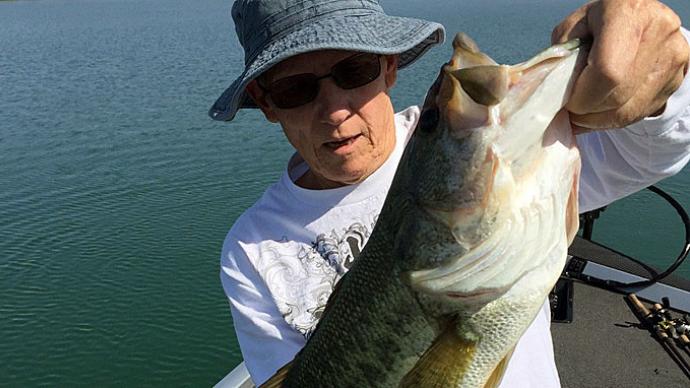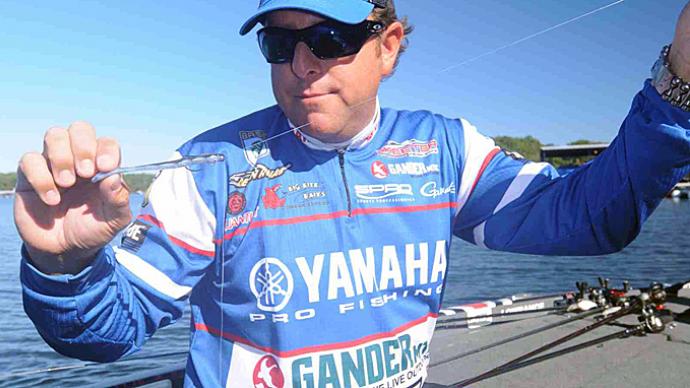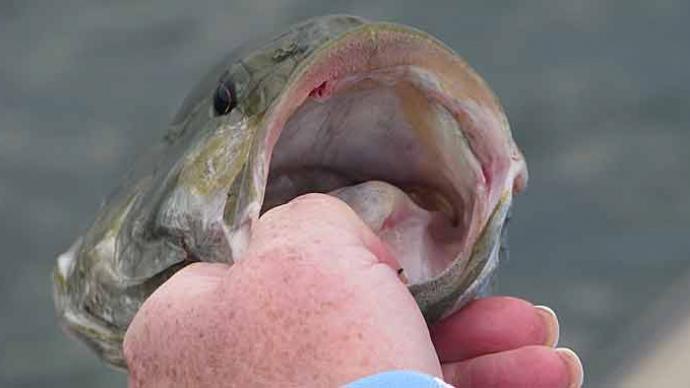
Clark Wendlandt has fished professionally for more than 25 years. He competed in B.A.S.S. tournaments but now follows the FLW Tour, where he finished fifth at the 2017 season stop at Lake Travis in Texas. He caught those bass from deep water, about 20 feet. That was out of character for the angler, better known for pursuing the ones he can see in shallow water. “Early in my career, if there were any chance to sight fish, I would do it every time,” he said.
A three-time FLW Tour Angler of the year, Wendlandt’s sight-fishing mastery has been responsible for two of his four wins. They both came at the annual springtime stop at Beaver Lake, where gin-clear Ozark Mountains water puts spawning bass in view. He enjoys sight fishing because its approach is similar to deer hunting, his other outdoors passion.
If targeting spawning bass isn’t against regulations where you fish, then sight fishing can be an exciting option. Watching a bass interact with your lure before striking it allows you to watch it. But it is rarely easy. Seeing a big bass nose down on your lure and then swimming away can introduce you to a new level of fishing frustration. Like most things in life, the more time you spend sight fishing, the better you will become at it.
Wendlandt said each spawning bass is different, but they all react similarly to their environment. So he takes a two-pronged approach to sight fishing. He looks at the bigger picture of conditions and the smaller picture of how each bass behaves. Success is found where those sets of information intersect.
Watch the calendar
Bass spawn in the spring, so their fry can strengthen before dealing with harsh winter conditions. Anglers have long used land-based queues, such as blooming dogwood trees, to estimate when the bass spawn is happening. But its timing has more to do with geography.
Wendlandt said the spawn lasts longer the farther south you travel. That’s because the water stays relatively warm during the mild winters. Some Florida bass, for example, spawn as early as December, while northern bass must wait for temperatures to rebound after several icy months. When those waters do warm, spawning happens quickly. “They’ve been waiting to do it for so long, so they just all do it at once,” he said.
In his home state —Texas — Wendlandt expects the spawn to start in March and end in April. Weather trends can alter that. This past winter, for example, was wacky. Much of the country basked in milder than usual temperatures. In response, he saw bass spawning in February.
Calendars will help your sight fishing in a specific way, and that’s by predicting the moon's phases. It takes 29.5 days to complete a cycle, from one full moon to the next. Wendlandt said most bass spawn around the full and new moons. He believes it’s the second-biggest influence on their spawning. He finds the largest on the screen of his electronics.
Watch the water and weather.
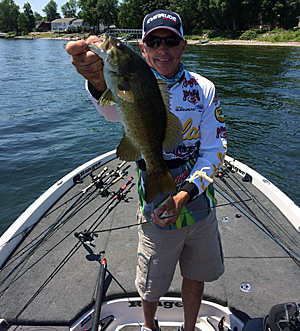
Ask ten bass anglers what’s the most important thing to know about sight fishing for bass, and it’s almost certain that all will say 65, the well-established threshold for the bass spawn. “Water temperature is probably the biggest factor,” Wendlandt said. In 65-degree water, the spawn is in high gear. But it happens in other temperatures, too. He said you could see fish for bass in cooler and warmer water, but they are often spookier and harder to catch. That’s because conditions aren’t prime.
Stable water temperature makes these bass easier to catch, Wendlandt said. Early in the spawning season, daytime water temperatures soar, only to be knocked back by much cooler nights. When those stay warm, water temperatures become consistent throughout the day. Bass that live in backwaters or the protected northwest corner of a lake, for example, usually see these conditions first.
Water level affects bedding bass. Wendlandt said rising water doesn’t concern them, but those in extremely shallow water will become spooky and eventually relocate as it falls. They can’t risk running out of water.
Weather plays a role, too. Wendlandt said wind can ripple the surface, making seeing spawners more difficult. It’s not unheard of for a strong cold front to return spawning bass to prespawn staging spots. Warm, sunny, stable springtime weather does more than improve your attitude. It can supercharge a wave of spawners, making it seem like there are bass on beds everywhere you look.
Watch the bass
Sight fishing starts by identifying a bass bed, which you’ll see before seeing the bass most times. They’re circular and can be a depression or clean spot on a hard surface, such as the deep edge of a little-used concrete boat ramp. They are made no deeper than sunlight can reach, so their depth can increase with the water clarity. The tell-tale attribute is its color, usually several shades lighter than the surrounding bottom. They also are usually made next to protection, such as a rock or log.
It might take a few minutes before you see the bass. Their coloring camouflages them, and they often hover just outside the bed. Wendlandt said the easiest way to read a spawning bass is by pitching your lure into its bed and watching its reaction. Does it rush over and pick it up, or does it scoot away and hide? He said bass that rush your lure are the easiest to catch. But they are the exceptions. Most are best described as inconsistent. They are individuals, so just because two bass are on adjacent beds, don’t expect them to react similarly. “Observation is a big key to sight fishing,” he said.
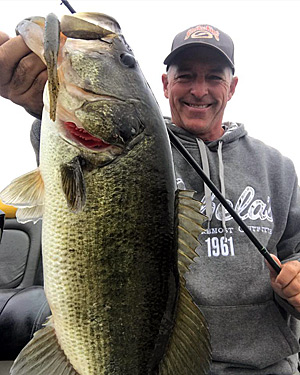
Wendlandt spends a reasonable amount of time watching a bass before making his first cast. He wants to know how far it will roam from the bed and if his boat’s presence will spook it. That will dictate where and how aggressively he presents his lure. Most bass become highly protective of one small spot in the bed. Put your lure on it, and a bite will come much quicker than fishing elsewhere in it. Taking the time to watch how a bass swims around the bed will disclose its location.
Wendlandt said spawning bass generally become spookier as they see more lures. “Even time of day can change their mood,” he said. If you hook a spawner and lose it, don’t hesitate to pitch back in. Chances are good that its strike was defensive, and when it returns to its bed, it will almost immediately be ready to strike again to protect its space.
If you do come across one that is spooky — leaves the bed when your boat gets close but returns — try fishing from farther away. “If you can see the fish, it can see you,” he said. You may have to retreat to a place where you can barely make out the bass. If that’s the case, look for a marker, such as a log, dock post, or clump of grass, which will give you a pitching or casting reference point. There are stories of anglers using golf balls to mark bed locations. Dropping a waypoint might be a better option, especially if you don’t want to tip off fellow tournament competitors.
Wendlandt said smallmouth are usually the easiest to catch. They are aggressive, so biting, not running, is their usual move. Spotted bass behave more like largemouth, he said. They are more unpredictable than their bronze-back cousins. Female bass are typically larger than males, regardless of species; how long they stick around a bed depends on the lake. Sometimes you never see the females, he said.
Patience can’t be overstressed. It starts with taking time to find a bass and continues by not surrendering to one that proves difficult to catch. Often a few minutes of standing still and watching the bass’ movements will even the playing field. You and the fish will settle down, making the catch more likely.
Watch your lure
Soft-plastic lures are the choice for sight fishing. They quietly slide into a bed when Texas rigged and come in an almost endless selection of styles. Many represent creatures that are known to eat bass eggs. For example, picking one that resembles a salamander, crawfish, or panfish is widely believed to unleash that all-important defensive strike from a bass.
Wendlandt said anglers could be divided into two camps based on how many lures they present to a bedding bass. Those anglers who rotate through several lures belonging to a group. They might start with a craw, switch to a worm and then try a small swimbait, searching for the one that draws a strike. Wendlandt belongs to the other group. His sight fishing lure is a Texas-rigged Strike King tube. He’ll use the 3.5-inch model for average bass and switch to the 4.5-inch one when targeting larger ones. He believes he can induce that same defensive strike by repeatedly presenting that one lure. Eventually, he said, the bass will tire of it and bite.
Choose a soft-plastic lure that’s easy to see. That helps you know when it’s in the bed, especially from longer distances, and when it disappears into a bass’ mouth. Many strikes aren’t violent. Bass will gently inhale your lure so they can move it elsewhere. White is a popular color choice, but dipping the tail into chartreuse or orange dye can create the same effect. A slightly heavier weight than you might use in shallow water can make your pitches easier and more accurate. It also will help keep your lure where you put it.


